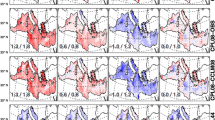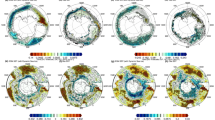Abstract
Based on 10 year climatological data and simulations from a regional atmosphere–ocean coupled model (FVCOM-RegCM3), this study examined the coupled seasonal and intraseasonal variability of atmospheric–oceanic variables [sea surface temperature (SST), winds, rainfall and heat fluxes] and important roles of coupling in the South China Sea. It is showed that even though both coupled and uncoupled models in general are able to capture observed seasonal and intraseasonal variability, the coupled model demonstrates stronger coupling relationship than the uncoupled model. For seasonal variability, the atmosphere–ocean relationship is presented as SST forcing atmosphere. Atmospheric variables are significantly influenced by strong seasonally-varied SST. The coupled model very accurately reproduced the observed SST variation with a stable equilibrium state, while SST from the uncoupled model gradually drifted away from the equilibrium state lacking of the so-called negative SST-heat flux feedback. Lead-lag analysis showed that the coupled variables demonstrated stronger SST-atmosphere relationship than the uncoupled and even observed variables. For intraseasonal variability, the atmosphere–ocean relationship is presented as atmosphere forcing SST. Wind becomes a dominant forcing and demonstrates robust negative relationship with SST and positive relationship with rainfall/LHF. Both coupled and uncoupled models are able to reproduce this observed relationship. In wind-SST relationship, compared to uncoupled and observed variables, the coupled model produced the smallest SST variances and therefore the strongest negative coupling feedback. Sensitivity experiments were also carried out to examine the roles of coupling by directly comparing differences between the coupled and uncoupled experiments with initial temperature perturbations. It is showed that the differences can be up to 50 % of the standard deviations of the variables. Root-mean-square errors of the uncoupled model can be effectively reduced by ~65 % in the coupled model.











Similar content being viewed by others
References
Carton JA, Chepurin G, Cao X, Giese BS (2000a) A simple ocean data assimilation analysis of the global upper ocean 1950–1995, part 1: methodology. J Phys Oceanogr 30:294–309
Carton JA, Chepurin G, Cao X (2000b) A simple ocean data assimilation analysis of the global upper ocean 1950–1995. Part 2: results. J Phys Oceanogr 30:311–326
Chen JM, Chang CP, Li T (2003a) Annual cycle of the South China Sea surface temperature using the NCEP/NCAR reanalysis. J Meteorol Soc Jpn 81(4):879–884
Chen C, Liu H, Beardsley RC (2003b) An unstructured, finite-volume, three-dimensional, primitive equation ocean model: application to coastal ocean and estuaries. J Atmos Oceanic Tech 20:159–186
Chen C, Beardsley RC, Cowles G (2006a) An unstructured grid, finite-volume coastal ocean model-FVCOM user manual. School for Marine Science and Technology, University of Massachusetts Dartmouth, New Bedford, Second Edition. Technical Report SMAST/UMASSD-06-0602
Chen C, Beardsley RC, Cowles G (2006b) An unstructured grid, finite-volume coastal ocean model (FVCOM) system. Special Issue entitled “Advance in Computational Oceanography”. Oceanography 19(1):78–89
Du Y, Qu T (2010) Three inflow pathways of the Indonesian throughflow as seen from the simple ocean data assimilation. Dyn Atmos Oceans 50:233–256
Fang G, Wang Y, Wei Z, Fang Y, Qiao F, Hu X (2009a) Interocean circulation and heat and freshwater budgets of the South China Sea based on a numerical model. Dyn Atmos Oceans 47:55–72
Fang Y, Zhang Y, Tang J, Ren X (2009b) A regional air-sea coupled model and its application over East Asia in the summer of 2000. Adv Atmos Sci. doi:10.1007/s00376-009-8203-7
Giorgi F, Marinucci MR, Bates GT (1993) Development of a second-generation regional climate model (RegCM2). Part I: boundary-layer and radiative transfer processes. Mon Weather Rev 121:2794–2813
Grell GA, Dudhia J, Stauffer DR (1994) Description of the fifth generation Penn State/NCAR Mesoscale Model (MM5), Technical Report TN-398+ STR. National Center for Atmospheric Research, Boulder
He ZQ, Wu RG (2013) Coupled seasonal variability in the South China Sea. J Oceanogr 69:57–69. doi:10.1007/s10872-012-0157-1
Holtslag AAM, de Bruijn EIF, Pan H-L (1990) A high-resolution air mass transformation model for short-range weather forecasting. Mon Weather Rev 118:1561–1575
Huffman GJ, Adler RF, Bolvin DT, Gu G, Nelkin EJ, Bowman KP, Hong Y, Stocker EF, Wolff DB (2007) The TRMM multi-satellite precipitation analysis: quasi-global, multi-year, combined-sensor precipitation estimates at fine scale. J Hydrometeorol 8:38–55
Jiang J, Qian Y (2000) The general character of precipitation over the South China Sea. ACTA Meteorol Sin 58(1):60–69
Kalnay E, Kanamitsu M et al (1996) The NCEP/NCAR 40-year reanalysis project. Bull Am Meteorol Soc 77:437–471
Kiehl JT, Hack JJ, Bonan GB, Boville BA, Breigleb BP, Williamson DL, Rasch PJ (1996) Description of the NCAR Community Climate Model (CCM3). In: NCAR technical note TN-420+ STR. http://www.cgd.ucar.edu/cms/ccm3/TN-420/
Lau KM, Ding YH, Wang JT, Johnson R, Keenan T, Cifelli R, Gerlach J, Thiele O, Rikenback T, Tay SC, Lin PH (2000) A report of the field operations and early results of the South China Sea Monsoon Experiment (SCSMEX). Bull Am Meteorol Soc 81:1261–1270
Lestari RK, Watanabe M, Kimoto M (2011) Role of atmosphere–ocean coupling in the interannual variability of the South China Sea summer monsoon. J Meteorol Soc Jpn 89A:283–290
Li T, Zhou GQ (2010) Preliminary results of a regional air-sea coupled model over East Asia. Chinese Sci Bull 55. doi:10.1007/s11434-010-0071-0
Liu WT, Xie XS (1999) Spacebased observations of the seasonal changes of South Asian monsoons and oceanic responses. Geophys Res Lett 26(10):1473–1476
Liu QY, Yang HJ, Liu ZY (2001a) Seasonal feature of the Sverdrup circulation in the South China Sea. Prog Nat Sci 11(3):202–206
Liu Z, Yang H, Liu Q (2001b) Regional dynamics of seasonal variability in the South China Sea. J Phys Oceanogr 31:272–284
Liu QY, Jiang X, Xie SP, Liu WT (2004) A gap in the Indo-Pacific warm pool over the South China Sea in boreal winter: seasonal development and interannual variability. J Geophys Res 109:C07012. doi:10.1029/2003JC002179
Mellor GL, Yamada T (1982) Development of a turbulence closure model for geophysical fluid problem. Rev Geophys Space Phys 20:851–875
Murakami T, Matsumoto J (1994) Summer monsoon over the Asian continent and western North Pacific. J Meteorol Soc Jpn 72:719–745
Pegion K, Kirtman B (2008) The impact of air–sea interactions on the simulation of tropical intraseasonal variability. J Clim 21:6616–6635
Qu T (2000) Upper-layer circulation in the South China Sea. J Phys Oceanogr 30:1450–1460
Qu TD (2001) Role of ocean dynamics in determining the mean seasonal cycle of the South China Sea surface temperature. J Geophys Res 106(C4):6943–6955
Qu T, Song YT, Yamagata T (2009) An introduction to the South China Sea through-flow: its dynamics, variability and application for climate. Dyn Atmos Oceans 47:3–14
Ren X, Qian Y (2005) A coupled regional air–sea model, its performances and climate drift in simulation of the east Asian summer monsoon in 1998. Int J Climatol 25:679–692
Smagorinsky J (1963) General circulation experiments with the primitive equations. I. The basic experiment. Mon Weather Rev 91:99–164
Sui D, Xie Q, Wang D (2012) A discuss on interannual to decadal variations of latent heat exchange over the South China Sea. Acta Oceanol Sin 34(4):27–34
Wang B, Lin Ho (2002) Rainy season of the Asian-Pacific summer monsoon. J Clim 15:386–398
Wang DX, Qin ZH, Zhou FX (1997) Study on air–sea interaction on the interannual time-scale in the South China Sea. Acta Meteorol Sin 55(1):33–42
Wang C, Wang W, Wang D, Wang Q (2006a) Interannual variability of the South China Sea associated with El Nino. J Geophys Res 111:C03023. doi:10.1029/2005JC003333
Wang D, Liu Q, Huang R et al (2006b) Interannual variability of the South China Sea throughflow inferred from wind data and an ocean data assimilation product. Geophys Res Lett 33:14. doi:10.1029/2006GL026316
Wang G, Huang W, Wang H (2006c) Study on the temporal and spatial variability of atmosphere–ocean flux over South China Sea with HOAPS data. Acta Oceanol Sin 28(4):1–8
Wang D, Zeng L, Li X, Shi P (2013a) Validation of satellite-derived daily latent heat flux over the South China Sea, compared with observations and five products. J Atmos Ocean Technol 30:1820–1832
Wang D et al (2013b) Progress of regional oceanography study associated with western boundary current in the South China Sea. Chin Sci Bull 58(11):1205–1215
Wei J, Malanotte-Rizzoli P, Eltahir EAB, Xue P, Xu D (2013) Coupling of a regional atmospheric model (RegCM3) and a regional ocean model (FVCOM) over the Maritime Continent. Dyn Clim. doi:10.1007/s00382-013-1983-6
Wu RG (2010) Subseasonal variability during the South China Sea summer monsoon onset. Clim Dyn 34:629–642. doi:10.1007/s00382-009-0679-4
Wu R, Kirtman B (2005) Roles of Indian and Pacific Ocean air–sea coupling in tropical atmospheric variability. Clim Dyn 25:155–170
Wu R, Wang B (2000) Interannual variability of summer monsoon onset over the western North Pacific and the underlying processes. J Clim 13:2483–2501
Wu R, Kirtman BP, Pegion K (2006) Local air–sea relationship in observations and model simulations. J. Climate 19:4914–4932
Wyrtki K(1961) Physical oceanography of the southeast Asian waters. Scientific results of marine investigations of the South China Sea and the Gulf of Thailand, NAGA report., no. 2. Scripps Inst. of Oceanogr., La Jolla
Xie SP, Chang CH, Xie Q, Wang DX (2007) Intraseasonal variability in the summer South China Sea: wind jet, cold filament, and recirculations. J Geophys Res 112:C10008. doi:10.1029/2007JC004238
Xu D, Malanotte-Rizzoli P (2013) Seasonal variation of the upper layer of the South China Sea and the Indonesian Seas: an ocean model study. Dyn Atmos Oceans 63:103–130. doi:10.1016/j.dynatmoce.2013.05.002
Zeng L, Wang D (2009) Intraseasonal variability of latent-heat flux in the South China Sea. Theor Appl Climatol 97:53–64
Zeng X, Zhao M, Dickinson RE (1998) Intercomparison of bulk aerodynamic algorithms for the computation of sea surface fluxes using TOGA COARE and TAO data. J Clim 11:2628–2644
Zeng L, Shi P, Liu W, Wang D (2009) Evaluation of a satellite-derived latent heat flux product in the South China Sea: a comparison with moored buoy data and various products. Atmos Res 94:91–105
Zhang Y, Wang D, Xia H, Zeng L (2012) The seasonal variability of an air–sea heat flux in the northern South China Sea. Acta Ocean Sin 31(5):79–86
Acknowledgments
This study was supported jointly by National Natural Science Foundation of China (No. 41106003), the Strategic Priority Research Program of the Chinese Academy of Sciences (No. XDA11010303) and by the Singapore National Research Foundation (NRF) through Center for Environmental Sensing and Monitoring (CENSAM) under the Singapore-MIT Alliance for Research and Technology (SMART) program.
Author information
Authors and Affiliations
Corresponding author
Rights and permissions
About this article
Cite this article
Wei, J., Wang, D., Li, M. et al. Coupled seasonal and intraseasonal variability in the South China Sea. Clim Dyn 44, 2463–2477 (2015). https://doi.org/10.1007/s00382-014-2250-1
Received:
Accepted:
Published:
Issue Date:
DOI: https://doi.org/10.1007/s00382-014-2250-1




